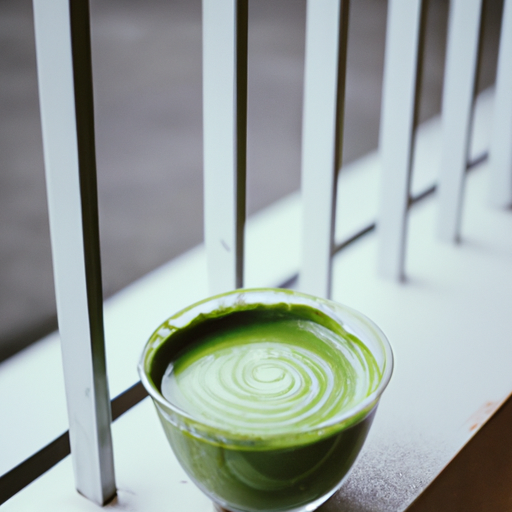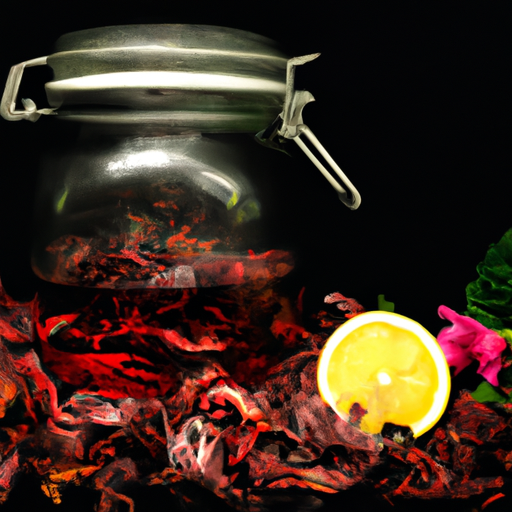Being a tea enthusiast, my interest in exploring various tea types has introduced me to some quite distinct blends. Nevertheless, I’ve felt somewhat daunted by the bright green hue and powdered form of matcha green tea.
That was until I finally decided to give it a try. I was pleasantly surprised by the complex and unique flavor profile that matcha has to offer. Matcha is a type of green tea that is grown and prepared differently than traditional loose leaf teas.
The leaves are shaded from the sun for several weeks before harvest, which increases the chlorophyll content and gives the tea its vibrant green color. Instead of steeping the leaves, matcha is ground into a fine powder and whisked with hot water. The result is a frothy, creamy tea with a distinct umami flavor.
In this article, we’ll explore the taste of matcha in more detail, as well as its health benefits, how to prepare it, and even some common myths about matcha.
Key Takeaways
- Matcha green tea has a unique flavor profile that is rich, vegetal, slightly sweet, and slightly bitter, providing complexity and sophistication.
- It is made from shade-grown tea leaves, ground into fine powder, and is more nutrient-dense than regular green tea, with a higher chlorophyll content that gives it a vibrant green color.
- Matcha green tea is prepared by whisking the powder with hot water, and contains antioxidants, amino acids, and L-theanine, making it popular for its health benefits and flavor profile.
- There are various grades of matcha green tea, including ceremonial, premium, and culinary, and five main flavor categories, including umami, sweet, bitter, vegetal, and floral, all of which contribute to its rich cultural significance in Japan as a meditative practice promoting relaxation and mindfulness.
What is Matcha Green Tea?
Matcha green tea is a finely ground powder made from shade-grown tea leaves. The tea leaves are carefully harvested, steamed, dried, and then ground into a fine powder using traditional stone mills.
This traditional method of Matcha production has been used for centuries in Japan and is known for its unique taste and health benefits. Matcha is often compared to regular green tea, but the two are quite different.
Unlike regular green tea, where the tea leaves are steeped and then discarded, Matcha is consumed in its entirety, making it more nutrient-dense. The shade-grown tea leaves used in Matcha production have a higher chlorophyll content, giving it its vibrant green color.
The unique flavor profile of Matcha is what sets it apart from other teas. Its rich, earthy flavor is often described as vegetal or grassy, with a slightly sweet finish. Matcha also has a slightly bitter taste, which is balanced by its sweetness.
This unique combination of flavors makes Matcha a favorite among tea enthusiasts.
The Unique Flavor Profile of Matcha
You’re in for a treat with the unique and complex flavor of this vibrant green powder. Matcha boasts a distinct taste profile that sets it apart from other types of tea. The flavor can be described as rich, vegetal, and slightly sweet.
To fully understand the taste profile of matcha, it’s best to break it down into its individual components. The table below outlines the five main flavor categories of matcha and the specific taste characteristics associated with each.
| Flavor Category | Taste Characteristics |
|---|---|
| Umami | Brothy, savory, meaty |
| Sweet | Honey-like, sugary |
| Bitter | Earthy, astringent |
| Vegetal | Grassy, spinach-like |
| Floral | Perfumed, fragrant |
When drinking matcha, all of these flavors come together in a harmonious way, creating a well-rounded and satisfying taste experience. The umami flavor, in particular, is what gives matcha its signature richness and depth.
Overall, matcha’s flavor profile is one of the key reasons why it has gained such popularity in recent years. Its unique taste is not only delicious, but also provides a sense of complexity and sophistication that is hard to find in other types of tea.
As for how to prepare matcha green tea, there are a few different methods, each with their own unique benefits and drawbacks. But before we get into that, let’s take a closer look at the different grades of matcha and how they can affect the taste of your tea.
How to Prepare Matcha Green Tea
Preparing this vibrant powder is as easy as whipping up a quick latte, but don’t let its simplicity fool you. To make a traditional matcha tea, you’ll only need a few essential tools: a bamboo whisk, a ceramic bowl, and a fine-mesh strainer. Here are the five simple steps to prepare a delicious matcha latte recipe:
- Sift 1-2 teaspoons of matcha powder into a bowl.
- Pour 2-3 ounces of hot water (not boiling) into the bowl and whisk until a frothy layer forms.
- Add 6-8 ounces of steamed milk and a sweetener of your choice.
- Whisk the mixture until fully combined.
- Pour the latte into your favorite mug and enjoy!
If you’re feeling a bit more adventurous, try incorporating matcha into your smoothie routine. Matcha smoothie ideas are limitless, but here are five popular options to get you started:
- Matcha Mango Smoothie: Blend frozen mango chunks, almond milk, matcha powder, and honey for a refreshing and energizing treat.
- Matcha Banana Smoothie: Combine frozen bananas, almond milk, matcha powder, and vanilla extract for a creamy and nutritious drink.
- Matcha Avocado Smoothie: Mix avocado, coconut milk, matcha powder, and lime juice for a creamy and tangy twist on your typical smoothie.
- Matcha Pineapple Smoothie: Blend frozen pineapple chunks, coconut milk, matcha powder, and ginger for a tropical and immune-boosting smoothie.
- Matcha Berry Smoothie: Combine mixed berries, almond milk, matcha powder, and chia seeds for a nutrient-dense and antioxidant-packed smoothie.
With these simple recipes, you’ll be able to elevate your matcha game in no time. But beyond its delicious taste, matcha offers an array of health benefits that make it an excellent addition to any diet.
Health Benefits of Matcha Green Tea
The health benefits of matcha green tea are numerous and varied, making it a valuable addition to any healthy lifestyle. Not only does matcha contain antioxidants and amino acids that promote overall wellness, but it also has unique benefits beyond health. Matcha has a rich cultural significance in Japan, where it has been used in traditional tea ceremonies for centuries. The preparation and consumption of matcha is a meditative practice that promotes relaxation and mindfulness.
In terms of health benefits, matcha is packed with antioxidants called catechins, which protect the body from free radical damage and promote healthy aging. Matcha also contains L-theanine, an amino acid that promotes relaxation and mental clarity. This combination of antioxidants and L-theanine makes matcha an ideal choice for a morning or midday pick-me-up without the jitters and crash associated with coffee.
Beyond its health benefits, matcha has a rich cultural significance in Japan. The preparation and consumption of matcha is a meditative practice that promotes relaxation and mindfulness. This practice dates back to the 12th century and is still widely practiced today. When drinking matcha, one savors each sip, taking in the aroma and flavor of the tea. The tea ceremony is a symbol of hospitality and respect, and is often used to mark important occasions such as weddings or business meetings.
When choosing the right matcha, it’s important to consider the quality and grade of the tea. High-quality matcha should have a vibrant green color and a smooth, creamy flavor. Look for matcha that is shade-grown and stone-ground to ensure the highest quality. By selecting the right matcha and taking the time to prepare and enjoy it, you can experience the numerous health benefits and cultural significance of this beloved beverage.
How to Choose the Right Matcha
When it comes to choosing the right matcha, there are a few key factors to consider.
First, you’ll want to think about the grade of matcha you’re looking for. There are various grades available, each with different qualities and price points.
Secondly, you’ll want to consider where to buy your matcha from. There are many online and brick-and-mortar stores that sell matcha, but not all sources are created equal.
As someone who’s researched and tasted many different matcha varieties, I can offer some helpful insights on how to make the best choice for your needs.
Grades of Matcha
If you’re a matcha lover, you’ll be pleased to know that higher grades of matcha have a sweeter taste that will leave you craving for more.
The Matcha grading system ranges from ceremonial grade, premium grade, and culinary grade.
Ceremonial grade matcha is made from the youngest tea leaves that are picked by hand and ground into a fine powder. This type of matcha is vibrant green in color, has a smooth and creamy texture, and has a subtle sweetness that is perfect for traditional tea ceremonies.
Premium grade matcha is made from slightly older tea leaves and is usually a bit less expensive than ceremonial grade matcha. This type of matcha has a slightly less vibrant green color, but still has a smooth and creamy texture. The taste of premium grade matcha is slightly stronger and has a slightly bitter edge.
Finally, culinary grade matcha is made from the oldest tea leaves and is usually used in cooking and baking. This type of matcha has a darker green color, a more bitter taste, and a coarser texture.
When it comes to matcha taste preferences, it’s important to know what type of matcha you’ll be using for what purpose. If you’re looking for a matcha to drink as a tea, ceremonial grade or premium grade matcha would be the best choice. However, if you’re looking to use matcha in cooking or baking, culinary grade matcha would be a better option.
Next, we’ll discuss where to buy matcha and how to ensure you’re getting a high-quality product.
Where to Buy Matcha
Now that we’ve discussed the various grades of matcha, let’s talk about where you can purchase it. As someone who enjoys a good cup of matcha, I can say that finding high-quality matcha can be a bit of a challenge. However, with a bit of research, I’ve found a few great options for those looking to purchase matcha.
Firstly, if you’re looking for high-quality matcha, I’d recommend looking for specialty tea stores or Japanese markets in your area. These stores often have a wider selection of matcha and can offer more information about the quality of the tea.
However, it’s important to note that high-quality matcha can come with a higher price tag. If affordability is a concern, there are also online retailers that offer matcha at more affordable prices. Just be sure to do your research and read reviews before making a purchase to ensure the quality of the matcha.
When it comes to finding high-quality matcha that fits your budget, it’s important to do your research and explore different options.
Now, let’s move on to the next section and explore what foods pair well with matcha.
What Foods Pair Well with Matcha
Matcha green tea pairs well with a variety of foods, including desserts like cupcakes and cookies. The rich and earthy flavor of matcha enhances the sweetness of these treats, making for a delicious combination.
Matcha can also be used in savory dishes, such as marinades for meat or as a seasoning for vegetables. Its unique taste adds depth and complexity to dishes in a way that other ingredients cannot.
Cooking with matcha is a fun way to experiment with this versatile ingredient. Some popular matcha food pairings include avocado toast, smoothie bowls, and sushi. The creaminess of avocado pairs well with the bitterness of matcha, while the sweetness of fruit in a smoothie bowl complements the earthy flavor of the tea. Matcha also adds a unique twist to sushi rolls, both in the flavor and appearance.
When cooking with matcha, it’s important to use high-quality, ceremonial-grade matcha. This ensures that the matcha is not bitter or overpowering in flavor. Additionally, it’s important to balance the amount of matcha used in a recipe, as too much can be overwhelming.
Overall, matcha is a versatile ingredient that can enhance the flavor of many dishes, both sweet and savory. It’s a unique ingredient that can add a depth of flavor to many dishes. With that said, it’s important to know how to store it to ensure its freshness.
How to Store Matcha Green Tea
To keep your matcha fresh and flavorful, you’ll want to store it in an airtight container away from light and heat, like a treasure chest guarding its valuable contents. Proper storage is crucial in maintaining the quality of your matcha, and here are a few things to keep in mind:
-
Avoid storing matcha in plastic bags or containers, as these can affect the taste and aroma of your tea. Instead, opt for ceramic or glass containers with airtight lids.
-
Keep your matcha away from direct sunlight, as exposure to UV rays can cause oxidation and diminish the quality of your tea.
-
Store your matcha in a cool, dry place to prevent moisture from seeping in and affecting the flavor.
-
It’s best to consume your matcha within 2-3 months of opening to ensure maximum freshness and taste.
By following these guidelines, you can ensure that your matcha stays fresh and delicious for as long as possible.
Now that we’ve covered the importance of proper storage, let’s move on to debunking some common matcha myths.
Common Matcha Myths Debunked
Don’t be fooled by common myths surrounding matcha – let’s set the record straight.
One of the most prevalent misconceptions about matcha is that it has an extremely high caffeine content. While it’s true that matcha does contain caffeine, it actually contains less caffeine than a cup of coffee. The caffeine in matcha is also balanced out by the presence of L-theanine, which promotes a state of calm alertness without the jitters commonly associated with caffeine.
Another common myth about matcha is that it can help with weight loss. While matcha does contain compounds that have been linked to weight loss, it’s important to remember that no single food or drink can magically make you lose weight. Matcha can be a healthy addition to a balanced diet and exercise routine, but it’s not a magic bullet for weight loss.
That being said, matcha can contribute to weight loss efforts by providing a low-calorie, nutrient-rich alternative to sugary drinks and snacks.
It’s important to separate fact from fiction when it comes to matcha. While it may not be a cure-all for caffeine or weight loss, matcha is a delicious and healthy beverage that can be enjoyed in moderation.
So go ahead and savor that cup of matcha – and know that you’re not just enjoying a trendy drink, but a beverage with a rich cultural history and potential health benefits.
Frequently Asked Questions
What is the caffeine content of matcha green tea compared to regular green tea?
When it comes to caffeine comparison, matcha green tea has a higher caffeine content than regular green tea. This is because matcha is made from grinding whole tea leaves into a fine powder, which means you consume the entire leaf and not just the brewed water.
In contrast, regular green tea is made from steeping the leaves in hot water and then discarding them. Matcha has a unique and distinct taste that can be described as earthy, vegetal, and slightly bitter. It also has a creamy and smooth texture that is not found in regular green tea.
Overall, if you’re looking for a higher caffeine content and a unique flavor profile, matcha green tea may be the perfect choice for you.
Can matcha green tea be used in cooking or baking, and if so, what are some recipes that use it?
I love using matcha green tea in my cooking and baking! Matcha has a unique flavor that pairs well with sweet and savory dishes.
Some popular matcha recipes include matcha lattes, matcha smoothie bowls, and matcha ice cream. You can also use matcha to make cakes, cookies, and even savory dishes like matcha risotto.
The culinary uses of matcha are endless, and it adds a beautiful green color to any dish. If you’re looking to experiment with matcha in your cooking, there are plenty of resources online with recipes and ideas.
Give it a try and see how matcha can elevate your culinary creations!
Is matcha green tea safe for pregnant or breastfeeding women to consume?
As a lover of matcha green tea, I can attest to its unique and earthy flavor that’s both sweet and bitter.
However, when it comes to the question of whether matcha green tea is safe for pregnant or breastfeeding women to consume, it’s important to consider the health benefits versus the risks.
According to expert opinions, consuming matcha green tea during pregnancy or breastfeeding is generally safe in moderation, as it contains antioxidants and compounds that can improve brain function and reduce the risk of certain diseases.
However, excessive consumption may lead to complications such as caffeine intake, which can lead to low birth weight or miscarriage.
As with any dietary decision during pregnancy or breastfeeding, it’s essential to speak with a healthcare provider to ensure the safety and health of both mother and baby.
How does the quality of the water used to prepare matcha green tea affect its flavor?
Water quality plays a crucial role in the flavor profile of matcha green tea. The brewing techniques and temperature control are also significant factors, but the water quality is crucial.
The taste of matcha can be altered based on the quality of water used to prepare it. Hard water with a high mineral content can make matcha taste bitter or chalky. On the other hand, soft water with a low mineral content can make matcha taste too weak. Therefore, it’s essential to use filtered or purified water to prepare matcha to enhance its flavor profile.
Temperature control is also crucial, and water that’s too hot can burn the leaves, resulting in a bitter taste. Therefore, it’s recommended to use water with a temperature of around 175°F to brew matcha to perfection.
Are there any potential side effects or risks associated with consuming matcha green tea?
As someone who enjoys drinking matcha green tea regularly, I can attest to its numerous benefits for both physical and mental health.
There are many studies and research that have shown the potential benefits of consuming matcha green tea such as boosting metabolism, improving cognitive function, and providing antioxidants to the body.
However, it’s important to consume matcha in moderation and be mindful of the dosage as long term consumption in high amounts may lead to health concerns.
It’s also important to note that there are potential risks associated with consuming matcha green tea, such as increased risk of liver damage and interactions with certain medications. Therefore, it’s important to consult with a healthcare professional before incorporating matcha into your diet.
Ultimately, consuming matcha green tea can have positive effects on your health, but it’s important to be mindful and informed about potential risks and benefits. As the adage goes, "moderation is key."
Conclusion
In conclusion, I must admit that after trying matcha green tea for the first time, I was pleasantly surprised by its unique flavor profile. The combination of earthy and savory notes, along with a subtle sweetness, makes it a truly delicious beverage. Plus, the added health benefits make it a no-brainer for those who want to incorporate more antioxidants into their diet.
Coincidentally, as I was sipping on my matcha latte, I received some great news that I’d been waiting for. Maybe it was the calming effect of the tea, or maybe it was just fate, but either way, I couldn’t help but feel grateful for this moment.
And now, every time I enjoy a cup of matcha, it reminds me to appreciate the small moments of joy in life.










